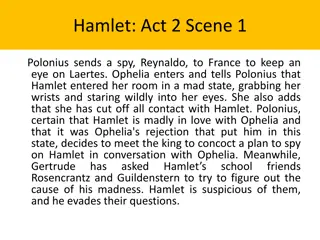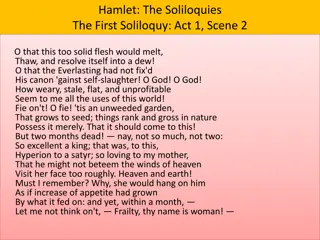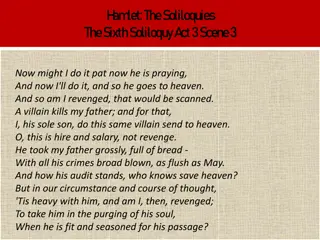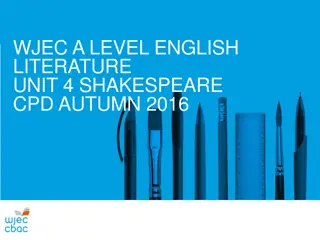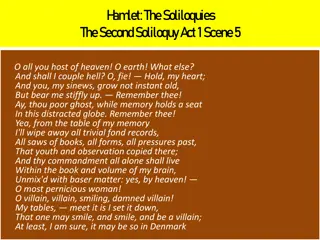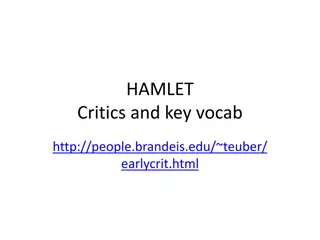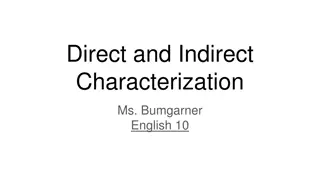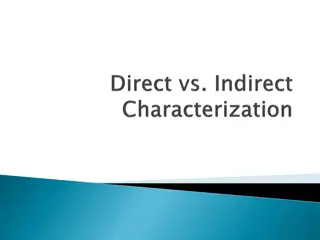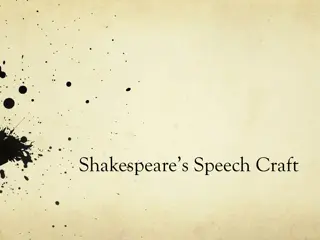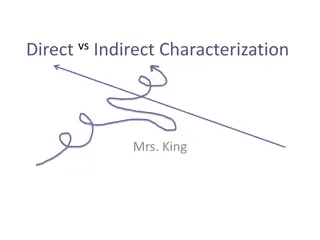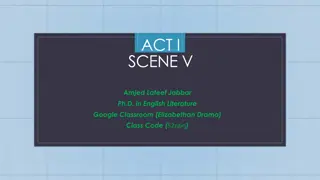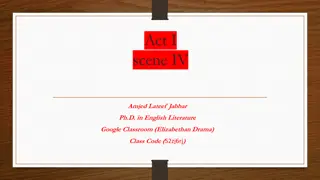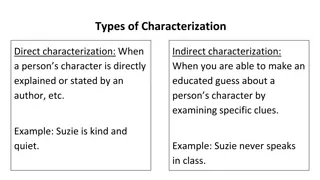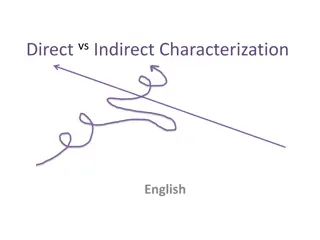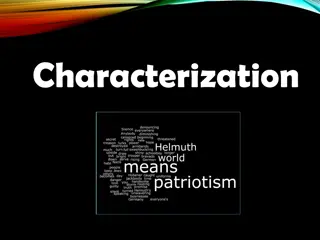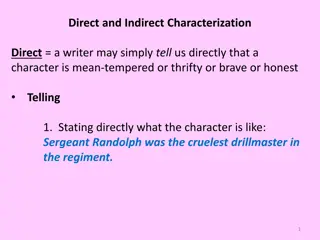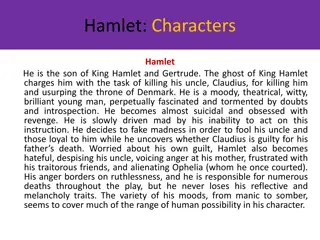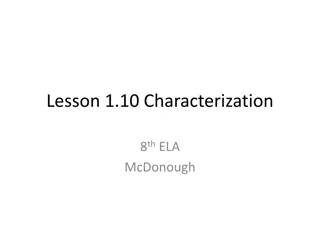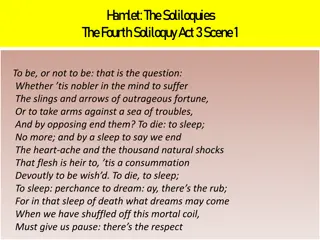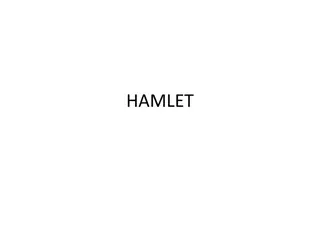Uncovering Theatrical Depths in Hamlet's Characterization
Unveiling the theatrical intricacies within Hamlet's character, this piece delves into the subtext of his actions and the underlying motives behind his feigned madness and calculated interactions, as depicted in A. Kernan's work "The Playwright as Magician". Through a close analysis of pivotal scenes, the narrative explores the layered nature of Hamlet's psyche and his strategic moves to shield himself from adversaries, providing a fresh perspective on Shakespeare's iconic protagonist.
Uploaded on Oct 08, 2024 | 0 Views
Download Presentation

Please find below an Image/Link to download the presentation.
The content on the website is provided AS IS for your information and personal use only. It may not be sold, licensed, or shared on other websites without obtaining consent from the author.If you encounter any issues during the download, it is possible that the publisher has removed the file from their server.
You are allowed to download the files provided on this website for personal or commercial use, subject to the condition that they are used lawfully. All files are the property of their respective owners.
The content on the website is provided AS IS for your information and personal use only. It may not be sold, licensed, or shared on other websites without obtaining consent from the author.
E N D
Presentation Transcript
General things to remember while writing! (from Purdue University) 1. Develop a topic based on what has already been said and written BUT Write something new and original 2. Rely on experts and authorities opinions BUT Improve on and/or disagree with those same opinions
3. Give credit to previous researchers BUT Make your own significant contributions 4. Improve your English to fit into a discourse community by building upon what you hear and read BUT Use your own words and your own voice
What is plagiarism? Buying Stealing Borrowing a paper (including copying an entire paper or article from the web) Hiring someone to write your paper for you Copying large sections of text from a source without quotations marks or proper citation Using the words of a source too closely when paraphrasing (without quotations) Building on someone s ideas without citing their spoken or written work
When do we NOT need to cite? Writing our own experiences, observations, thoughts, conclusions Writing our own results from our analysis While using our own videos, audios, etc. While using common knowledge : folklore, myths, historical events (not historical documents) When using generally-accepted facts
How do decide if sth is common knowledge If you find the same information undocumented in at least five credible sources If you think your readers will already know the information If you think a person can easily find it in general reference sources PS: If in doubt, CITE!!
PLAGIARISM EXAMPLES (taken from Princeton University)
Sample 1 Original source (text) Kernan, A. (1979).The Playwright as Magician. New Haven: Yale University Press, 1979. From time to time this submerged or latent theater in becomes almost overt. It is close to the surface in Hamlet s pretense of madness, the antic disposition he puts on to protect himself and prevent his antagonists from plucking out the heart of his mystery. It is even closer to the surface when Hamlet enters his mother s room and holds up, side by side, the pictures of the two kings, Old Hamlet and Claudius, and proceeds to describe for her the true nature of the choice she has made, presenting truth by means of a show. Similarly, when he leaps into the open grave at Ophelia s funeral, ranting in high heroic terms, he is acting out for Laertes, and perhaps for himself as well, the folly of excessive, melodramatic expressions of grief.
Sample 1 Original source (text) From time to time this submerged or latent theater in becomes almost overt. It is close to the surface in Hamlet s pretense of madness, the antic disposition he puts on to protect himself and prevent his antagonists from plucking out the heart of his mystery. It is even closer to the surface when Hamlet enters his mother s room and holds up, side by side, the pictures of the two kings, Old Hamlet and Claudius, and proceeds to describe for her the true nature of the choice she has made, presenting truth by means of a show. Similarly, when he leaps into the open grave at Ophelia s funeral, ranting in high heroic terms, he is acting out for Laertes, and perhaps for himself as well, the folly of excessive, melodramatic expressions of grief. Verbatim plagiarism, or unacknowledged direct quotation (lifted passages are underlined) Almost all of Shakespeare s Hamlet can be understood as a play about acting and the theater. For example, there is Hamlet s pretense of madness, the antic disposition that he puts on to protect himself and prevent his antagonists from plucking out the heart of his mystery. When Hamlet enters his mother s room, he holds up, side by side, the pictures of the two kings, Old Hamlet and Claudius, and proceeds to describe for her the true nature of the choice she has made, presenting truth by means of a show. Similarly, when he leaps into the open grave at Ophelia s funeral, ranting in high heroic terms, he is acting out for Laertes, and perhaps for himself as well, the folly of excessive, melodramatic expressions of grief.
Sample 1 Original source (text) Almost entire passage is taken word-for-word from the source; no citation and quotation marks From time to time this submerged or latent theater in becomes almost overt. It is close to the surface in Hamlet s pretense of madness, the antic disposition he puts on to protect himself and prevent his antagonists from plucking out the heart of his mystery. It is even closer to the surface when Hamlet enters his mother s room and holds up, side by side, the pictures of the two kings, Old Hamlet and Claudius, and proceeds to describe for her the true nature of the choice she has made, presenting truth by means of a show. Similarly, when he leaps into the open grave at Ophelia s funeral, ranting in high heroic terms, he is acting out for Laertes, and perhaps for himself as well, the folly of excessive, melodramatic expressions of grief. Verbatim plagiarism, or unacknowledged direct quotation (lifted passages are underlined) Almost all of Shakespeare s Hamlet can be understood as a play about acting and the theater. For example, there is Hamlet s pretense of madness, the antic disposition that he puts on to protect himself and prevent his antagonists from plucking out the heart of his mystery. When Hamlet enters his mother s room, he holds up, side by side, the pictures of the two kings, Old Hamlet and Claudius, and proceeds to describe for her the true nature of the choice she has made, presenting truth by means of a show. Similarly, when he leaps into the open grave at Ophelia s funeral, ranting in high heroic terms, he is acting out for Laertes, and perhaps for himself as well, the folly of excessive, melodramatic expressions of grief.
Sample 2 Original source (text) From time to time this submerged or latent theater in Hamlet becomes almost overt. It is close to the surface in Hamlet s pretense of madness, the antic disposition he puts on to protect himself and prevent his antagonists from plucking out the heart of his mystery. It is even closer to the surface when Hamlet enters his mother s room and holds up, side by side, the pictures of the two kings, Old Hamlet and Claudius, and proceeds to describe for her the true nature of the choice she has made, presenting truth by means of a show. Similarly, when he leaps into the open grave at Ophelia s funeral, ranting in high heroic terms, he is acting out for Laertes, and perhaps for himself as well, the folly of excessive, melodramatic expressions of grief. Lifting selected passages and phrases without proper acknowledgment (lifted passages are underlined) Almost all of Shakespeare s Hamlet can be understood as a play about acting and the theater. For example, in Act 1, Hamlet adopts a pretense of madness that he uses to protect himself and prevent his antagonists from discovering his mission to revenge his father s murder. He also presents truth by means of a show when he compares the portraits of Gertrude s two husbands in order to describe for her the true nature of the choice she has made. And when he leaps in Ophelia s open grave ranting in high heroic terms, Hamlet is acting out the folly of excessive, melodramatic expressions of grief.
Sample 2 Original source (text) From time to time this submerged or latent theater in Hamlet becomes almost overt. It is close to the surface in Hamlet s pretense of madness, the antic disposition he puts on to protect himself and prevent his antagonists from plucking out the heart of his mystery. It is even closer to the surface when Hamlet enters his mother s room and holds up, side by side, the pictures of the two kings, Old Hamlet and Claudius, and proceeds to describe for her the true nature of the choice she has made, presenting truth by means of a show. Similarly, when he leaps into the open grave at Ophelia s funeral, ranting in high heroic terms, he is acting out for Laertes, and perhaps for himself as well, the folly of excessive, melodramatic expressions of grief. Much of the paragraph rewritten, and fewer phrases lifted verbatim; still plagiarism: no quotation marks and no citing the author. Even use of only high heroic terms requires citation Lifting selected passages and phrases without proper acknowledgment (lifted passages are underlined) Almost all of Shakespeare s Hamlet can be understood as a play about acting and the theater. For example, in Act 1, Hamlet adopts a pretense of madness that he uses to protect himself and prevent his antagonists from discovering his mission to revenge his father s murder. He also presents truth by means of a show when he compares the portraits of Gertrude s two husbands in order to describe for her the true nature of the choice she has made. And when he leaps in Ophelia s open grave ranting in high heroic terms, Hamlet is acting out the folly of excessive, melodramatic expressions of grief.
Sample 3 Original source (text) From time to time this submerged or latent theater in Hamlet becomes almost overt. It is close to the surface in Hamlet s pretense of madness, the antic disposition he puts on to protect himself and prevent his antagonists from plucking out the heart of his mystery. It is even closer to the surface when Hamlet enters his mother s room and holds up, side by side, the pictures of the two kings, Old Hamlet and Claudius, and proceeds to describe for her the true nature of the choice she has made, presenting truth by means of a show. Similarly, when he leaps into the open grave at Ophelia s funeral, ranting in high heroic terms, he is acting out for Laertes, and perhaps for himself as well, the folly of excessive, melodramatic expressions of grief. Paraphrasing the text while maintaining the basic paragraph and sentence structure Almost all of Shakespeare s Hamlet can be understood as a play about acting and the theater. For example, in Act 1, Hamlet pretends to be insane in order to make sure his enemies do not discover his mission to revenge his father s murder. The theme is even more obvious when Hamlet compares the pictures of his mother s two husbands to show her what a bad choice she has made, using their images to reveal the truth. Also, when he jumps into Ophelia s grave, hurling his challenge to Laertes, Hamlet demonstrates the foolishness of exaggerated expressions of emotion.
Sample 3 Original source (text) From time to time this submerged or latent theater in Hamlet becomes almost overt. It is close to the surface in Hamlet s pretense of madness, the antic disposition he puts on to protect himself and prevent his antagonists from plucking out the heart of his mystery. It is even closer to the surface when Hamlet enters his mother s room and holds up, side by side, the pictures of the two kings, Old Hamlet and Claudius, and proceeds to describe for her the true nature of the choice she has made, presenting truth by means of a show. Similarly, when he leaps into the open grave at Ophelia s funeral, ranting in high heroic terms, he is acting out for Laertes, and perhaps for himself as well, the folly of excessive, melodramatic expressions of grief. No original language remains, but key idea, choice and order of examples are the same; still plagiarism Paraphrasing the text while maintaining the basic paragraph and sentence structure Almost all of Shakespeare s Hamlet can be understood as a play about acting and the theater. For example, in Act 1, Hamlet pretends to be insane in order to make sure his enemies do not discover his mission to revenge his father s murder. The theme is even more obvious when Hamlet compares the pictures of his mother s two husbands to show her what a bad choice she has made, using their images to reveal the truth. Also, when he jumps into Ophelia s grave, hurling his challenge to Laertes, Hamlet demonstrates the foolishness of exaggerated expressions of emotion.
EXERCISE EXERCISE 1. Explain why there is or is not plagiarism in 1. Explain why there is or is not plagiarism in the passage from the student's essay. the passage from the student's essay. From Michael Ventura's "The Tools of an Animal": Different tools shape words differently, the way different tools build furniture and shoes differently.... Pen and paper are slow and messy, of course. Modernity loves speed and claims to hate mess. But speed is only a value when it's useful, and it isn't always useful. Slowness can be useful too. Using an instrument that doesn't let you go too fast can make you pause where you might not have, and a pause at the right time can change or even save your life, not to mention your work. From a student's essay: Most writers have come to depend on computers, and they can't imagine writing a paper without one. But, in an essay titled "The Tools of an Animal," Michael Ventura reminds us that sometimes computers aren't the right tool for a writer's task, sometimes using an instrument that doesn't let you go too fast can make you pause at a crucial point--and this pause may save your work from failure. Works Cited Ventura, M. (1994). The Tools of an Animal. The Independent Weekly,20, 5-7.
EXERCISE EXERCISE 1. Explain why there is or is not plagiarism in 1. Explain why there is or is not plagiarism in the passage from the student's essay. the passage from the student's essay. From Michael Ventura's "The Tools of an Animal": Different tools shape words differently, the way different tools build furniture and shoes differently.... Pen and paper are slow and messy, of course. Modernity loves speed and claims to hate mess. But speed is only a value when it's useful, and it isn't always useful. Slowness can be useful too. Using an instrument that doesn't let you go too fast can make you pause where you might not have, and a pause at the right time can change or even save your life, not to mention your work. From a student's essay: Most writers have come to depend on computers, and they can't imagine writing a paper without one. But, in an essay titled "The Tools of an Animal," Michael Ventura reminds us that sometimes computers aren't the right tool for a writer's task, sometimes using an instrument that doesn't let you go too fast can make you pause at a crucial point--and this pause may save your work from failure. Works Cited Ventura, M. (1994). The Tools of an Animal. The Independent Weekly,20, 5-7. There is plagiarism in the passage because the student borrows Ventura's exact words without using quotation marks.
Exercise Exercise 2/ the passage from the student's essay. the passage from the student's essay. 2/ Explain why there is or is not plagiarism in Explain why there is or is not plagiarism in From William Zinsser's On Writing Well: Good writing has an aliveness that keeps the reader reading from one paragraph to the next, and it's not a question of gimmicks to "personalize the author. It s a question of using the English language in a way that will achieve the greatest strength and the least clutter. From a student's essay: An important quality of good writing is "aliveness" (Zinsser, 1985). To achieve aliveness, a writer must avoid gimmicks and instead use the English language to achieve great strength and a minimal amount of clutter. Works Cited Zinsser, W. (1985). On Writing Well: An Informal Guide to Writing Nonfiction (3rd Ed). New York: Harper.
Exercise Exercise 2/ the passage from the student's essay. the passage from the student's essay. 2/ Explain why there is or is not plagiarism in Explain why there is or is not plagiarism in From William Zinsser's On Writing Well: Good writing has an aliveness that keeps the reader reading from one paragraph to the next, and it's not a question of gimmicks to "personalize the author. It s a question of using the English language in a way that will achieve the greatest strength and the least clutter. From a student's essay: An important quality of good writing is "aliveness" (Zinsser, 1985). To achieve aliveness, a writer must avoid gimmicks and instead use the English language to achieve great strength and a minimal amount of clutter. Works Cited Zinsser, W. (1985). On Writing Well: An Informal Guide to Writing Nonfiction (3rd Ed). New York: Harper. There is plagiarism because the student s second sentence paraphrases from Zinsser without documentation. It seems as if to achieve aliveness is the students ideas: the student s paraphrase also borrows too closely from the original.
Exercise Exercise 3/ passage from the student's essay. passage from the student's essay. 3/ Explain why there is or is not plagiarism in the Explain why there is or is not plagiarism in the From James L. Kinneavy, William McCleary, and Neil Nakadate's Writing in the Liberal Arts Tradition: The goal of learning to write "in the liberal arts tradition" is the well-rounded writer-- a person with training and experience in a range of writing tasks, from term papers to poems and stories. From a student's essay: Kinneavy, William, and Nakadate (1998) believe that "the goal of learning to write 'in the liberal arts tradition' is the well-rounded writer" (p. xiii). A well-rounded writer, they explain is one with training and practice in a variety of writing tasks (p. xiii). Works Cited Kinneavy, J. L., William, J., and Nakadate, N. (1998). Writing in the Liberal Arts Tradition: A Rhetoric with Readings. New York: Harper.
Exercise Exercise 3/ A passage from the student's essay. passage from the student's essay. 3/ A. Explain why there is or is not plagiarism in the . Explain why there is or is not plagiarism in the From James L. Kinneavy, William McCleary, and Neil Nakadate's Writing in the Liberal Arts Tradition: The goal of learning to write "in the liberal arts tradition" is the well- rounded writer-- a person with training and experience in a range of writing tasks, from term papers to poems and stories. From a student's essay: Kinneavy, McCleary, and Nakadate (1998) believe that "the goal of learning to write 'in the liberal arts tradition' is the well-rounded writer" (p. xiii). A well-rounded writer, they explain is one with training and practice in a variety of writing tasks (p. xiii). Works Cited Kinneavy, J. L., William J., and Nakadate, N. (1998). Writing in the Liberal Arts Tradition: A Rhetoric with Readings. New York: Harper. There is no plagiarism in this passage. The student s paraphrase in the second sentence is appropriately referenced.
Exercise Exercise 4. the passage from the student's essay. the passage from the student's essay. 4. Explain why there is or is not plagiarism in Explain why there is or is not plagiarism in From a lecture by John C. Bean: Who among us begins writing an article by choosing a topic, narrowing it, and then writing a thesis statement and outline? Rather, most of us begin by being gradually drawn into a conversation about a question in our disciplines that doesn't yet seem resolved. We find something unsatisfying about this conversation; something is missing.... Whatever the source of our puzzlement, our own writing originates in our sense of a conflict or question. From a student's essay: Often, people view the writing process as a rigid series of steps. First, you choose a topic, then you form a thesis. An outline precedes the first draft, revision succeeds the first draft and editing is always the final step. In practice, however, the writing process is not nearly so clear cut. For instance, Bean (1989) argues that writing often begins not with a thesis but with a question. References Bean, J. C. (1989, October). Lecture presented at Gustavus Adolphus College, St. Peter, MN.
Exercise Exercise 4. the passage from the student's essay. the passage from the student's essay. 4. Explain why there is or is not plagiarism in Explain why there is or is not plagiarism in From a lecture by John C. Bean: Who among us begins writing an article by choosing a topic, narrowing it, and then writing a thesis statement and outline? Rather, most of us begin by being gradually drawn into a conversation about a question in our disciplines that doesn't yet seem resolved. We find something unsatisfying about this conversation; something is missing.... Whatever the source of our puzzlement, our own writing originates in our sense of a conflict or question. From a student's essay: Often, people view the writing process as a rigid series of steps. First, you choose a topic, then you form a thesis. An outline precedes the first draft, revision succeeds the first draft and editing is always the final step. In practice, however, the writing process is not nearly so clear cut. For instance, Bean (1989) argues that writing often begins not with a thesis but with a question. References Bean, J. C. (1989, October). Lecture presented at Gustavus Adolphus College, St. Peter, MN. There is no plagiarism in the student s passage because appropriate attribution and citations are used to acknowledge the ideas borrowed from Bean. (In APA documentation, a page number is not required for summaries or paraphrases, but the date is.)
Exercise Exercise 5/ the passage from the student's essay. the passage from the student's essay. 5/ Explain why there is or is not plagiarism in Explain why there is or is not plagiarism in From Edward Abbey's "Come on In": The canyon country of southern Utah and northern Arizona is something special. Something else. Something strange, marvelous, full of wonders. So far as I know there is no other region on earth much like it, or even remotely like it. Nowhere else have we had this lucky combination of vast sedimentary rock formations exposed to a desert climate, of a great plateau carved by major rivers--the Green, the San Juan, the Colorado- into such a wonderland of form and color. From a student's essay: In a short essay titled "Come on In," Abbey (2001) introduces his readers to the wonders of the canyon country in the American Southwest. This area has a fortunate combination of extensive sedimentary rocks exposed to a desert environment and a great plateau shaped by important rivers. For Abbey, it is "a wonderland of form and color" (p. 3). Works Cited Abbey, E. (2001). Come on In. Plateau, 49(1), pp. 3-5.
Exercise Exercise 5/ the passage from the student's essay. the passage from the student's essay. 5/ Explain why there is or is not plagiarism in Explain why there is or is not plagiarism in From Edward Abbey's "Come on In": The canyon country of southern Utah and northern Arizona is something special. Something else. Something strange, marvelous, full of wonders. So far as I know there is no other region on earth much like it, or even remotely like it. Nowhere else have we had this lucky combination of vast sedimentary rock formations exposed to a desert climate, of a great plateau carved by major rivers--the Green, the San Juan, the Colorado-into such a wonderland of form and color. From a student's essay: In a short essay titled "Come on In," Abbey (2001) introduces his readers to the wonders of the canyon country in the American Southwest. This area has a fortunate combination of extensive sedimentary rocks exposed to a desert environment and a great plateau shaped by important rivers. For Abbey, it is "a wonderland of form and color" (p. 3). Works Cited Abbey, E. (2001). Come on In. Plateau, 49(1), pp. 3-5. There is plagiarism because the student s second sentence borrows from the source but does not acknowledge the borrowing with documentation or attribution. The student s paraphrase in this sentence is also too close to the original. She should use her own sentence structure.
Exercise 6 Explain why there is or is not plagiarism in Explain why there is or is not plagiarism in the passage from the student's essay. the passage from the student's essay. From Peter G. Rowlands' "Climatic Factors and the Distribution of Woodland Vegetation in the Southwest": In conclusion, there is a latitudinal, phytogeographic anomaly in the Southwest taking the form of declining woodland vegetation zones along a decreasing latitudinal and longitudinal gradient. This anomaly can be associated with the decline of the AHB [arid-humid boundary] from the northwest to the southeast between approximately 38'N and 31'20'N latitude. This decline in the AHB is a function of increasing summer precipitation along the same gradient. From a student's essay: An unusual relationship exists between the distribution of vegetation and latitude in Arizona and New Mexico: The lower limit of tree growth drops with decreasing latitude rather than rising, as one would expect. Rowlands (1993) demonstrated that this anomaly can be associated with the decline of the arid humid boundary. References Rowlands P. G. (1993). Climatic factors and the distribution of woodland vegetation in the Southwest. Southwestern Nat, 38, pp.135- 197.
Exercise 6 Explain why there is or is not plagiarism in Explain why there is or is not plagiarism in the passage from the student's essay. the passage from the student's essay. From Peter G. Rowlands' "Climatic Factors and the Distribution of Woodland Vegetation in the Southwest": In conclusion, there is a latitudinal, phytogeographic anomaly in the Southwest taking the form of declining woodland vegetation zones along a decreasing latitudinal and longitudinal gradient. This anomaly can be associated with the decline of the AHB [arid-humid boundary] from the northwest to the southeast between approximately 38'N and 31'20'N latitude. This decline in the AHB is a function of increasing summer precipitation along the same gradient. From a student's essay: An unusual relationship exists between the distribution of vegetation and latitude in Arizona and New Mexico: The lower limit of tree growth drops with decreasing latitude rather than rising, as one would expect. Rowlands (1993) demonstrated that this anomaly can be associated with the decline of the arid humid boundary. References Rowlands P. G. (1993). Climatic factors and the distribution of woodland vegetation in the Southwest. Southwestern Nat, 38, pp.135-197. There is plagiarism (minor) because the student quotes directly from the source in her second sentence and does not use quotation marks.
Exercise Exercise 7/ the passage from the student's essay. the passage from the student's essay. 7/ Explain why there is or is not plagiarism in Explain why there is or is not plagiarism in From Steven D. Emslie, Robert C. Euler, and Jim 1. Mead's "A Desert Culture Shrine in Grand Canyon, Arizona, and the Role of Split-twig Figurines": Most of the known figurine sites in Grand Canyon share an apparent correlation with the caves containing remains of the extinct mountain goat (though these remains are considerably older than the artifacts) and remains of bighorn sheep, . . . The authors think the correlation of figurines with Oreamnos or Ovis remains is not accidental, and that the presence of these remains in a cave was the reason a site was selected for the deposition of figurines. From a student' essay: Since the 1933 discovery of split-willow figurines in the Grand Canyon archaeologists have been speculating about the function these simple figures played in the cultures of early Canyon dwellers. Emslie, Euler, and Mead (1987), for instance, have observed that the figurines we often found in caves with fossils from mountain goats and bighorn sheep. They believe that this correlation is not an accident. References Emslie, S. D., Euler, R. C., & Mead, J. (1987). A desert culture shrine in Grand Canyon, Arizona, and the role of split-twig figurines. National Geographic Research,3, 511-516.
Exercise Exercise 7/ the passage from the student's essay. the passage from the student's essay. 7/ Explain why there is or is not plagiarism in Explain why there is or is not plagiarism in From Steven D. Emslie, Robert C. Euler, and Jim 1. Mead's "A Desert Culture Shrine in Grand Canyon, Arizona, and the Role of Split-twig Figurines": Most of the known figurine sites in Grand Canyon share an apparent correlation with the caves containing remains of the extinct mountain goat (though these remains are considerably older than the artifacts) and remains of bighorn sheep, . . . The authors think the correlation of figurines with Oreamnos or Ovis remains is not accidental, and that the presence of these remains in a cave was the reason a site was selected for the deposition of figurines. From a student' essay: Since the 1933 discovery of split-willow figurines in the Grand Canyon archaeologists have been speculating about the function these simple figures played in the cultures of early Canyon dwellers. Emslie, Euler, and Mead (1987), for instance, have observed that the figurines we often found in caves with fossils from mountain goats and bighorn sheep. They believe that this correlation is not an accident. References Emslie, S. D., Euler, R. C., & Mead, J. (1987). A desert culture shrine in Grand Canyon, Arizona, and the role of split-twig figurines. National Geographic Research, 3, 511-516. There is no plagiarism in this passage because the student uses attribution and documentation to acknowledge appropriately the information borrowed from the source.
Exercise 8/ Explain why there is or is not plagiarism in the Explain why there is or is not plagiarism in the passage from the student's essay. passage from the student's essay. From Ann H. Zwinger's forward to The Grand Canyon: Intimate Views: I first went down the Colorado River in the Grand Canyon in May of 1976, just after writing a book on the Green River, during which tune I had studiously avoided run-ning the Colorado River because I didn't want to lose focus, didn't want to be over-whelmed by this massive canyon, this overpowering river. When that book was over- and published, I wanted to complete my time of river running with the ultimate: the Colorado River in the Grand Canyon, sure that I would write no more river books, do no more river trips, and this rowing trip would be the grand finale (so to speak), the ne plus ultra. From a student's essay: Though Zwinger (1992) devoted much of her adult life to studying and writing about rivers, she carefully avoided the Colorado River for many years. Zwinger didn't want to be overcome by this magnificent river. Instead, she wanted to save the Colorado River until the end of her career as a river runner, believing that it "would be the grand finale" (p. ix). Works Cited Zwinger, A. H. (1992). The Grand Canyon: Intimate Views. Tucson: U of Arizona P.
Exercise 8/ Explain passage from the student's essay. passage from the student's essay. Explain why there is or is not plagiarism in the why there is or is not plagiarism in the From Ann H. Zwinger's forward to The Grand Canyon: Intimate Views: I first went down the Colorado River in the Grand Canyon in May of 1976, just after writing a book on the Green River, during which tune I had studiously avoided run-ning the Colorado River because I didn't want to lose focus, didn't want to be over-whelmed by this massive canyon, this overpowering river. When that book was over- and published, I wanted to complete my time of river running with the ultimate: the Colorado River in the Grand Canyon, sure that I would write no more river books, do no more river trips, and this rowing trip would be the grand finale (so to speak), the ne plus ultra. From a student's essay: Though Zwinger (1992) devoted much of her adult life to studying and writing about rivers, she carefully avoided the Colorado River for many years. Zwinger didn't want to be overcome by this magnificent river. Instead, she wanted to save the Colorado River until the end of her career as a river runner, believing that it "would be the grand finale" (p. ix). Works Cited Zwinger, A. H. (1992). The Grand Canyon: Intimate Views. Tucson: U of Arizona P. There is no plagiarism in this passage.
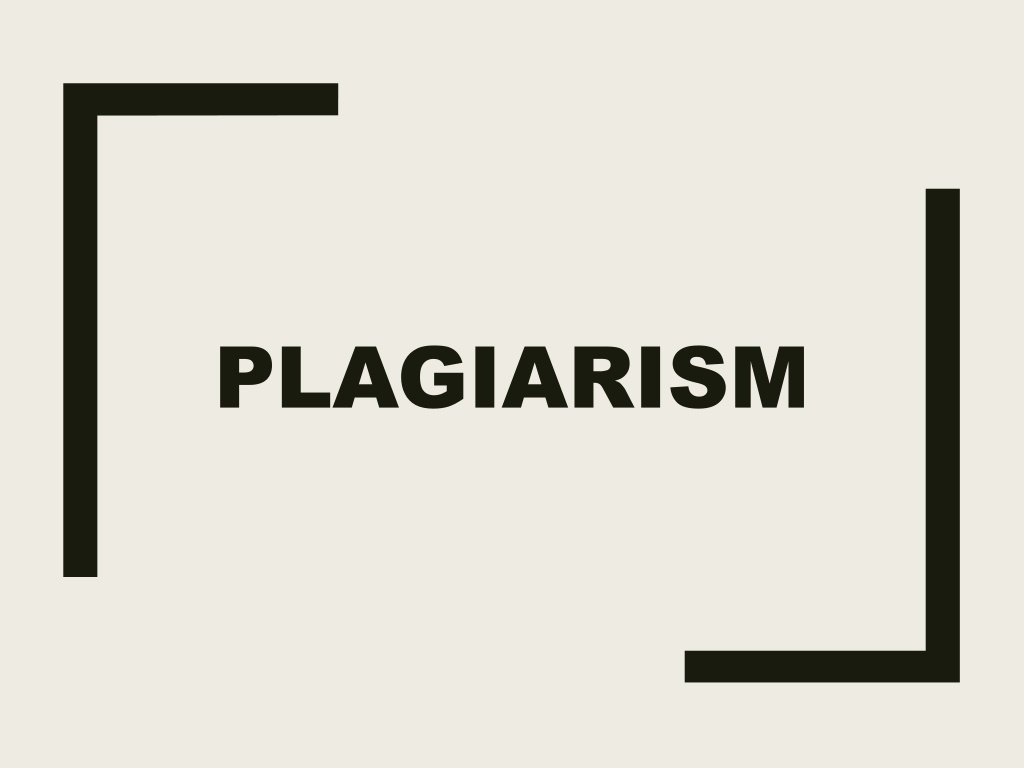
 undefined
undefined

